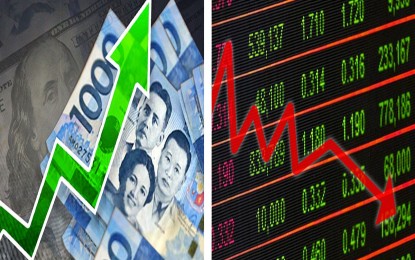
MANILA -- The Philippine peso recovered Friday on additional moves globally to combat the novel coronavirus (2019-nCoV) epidemic but investors’ concerns on the issue continue to hurt the local equities market.
The local currency finished the trade at 50.83 from 50.96 a day ago to a US dollar, which BPI Research attributed to the declaration by the World Health Organization (WHO) of an international health emergency vis-à-vis the rise of 2019-nCoV cases and death.
It opened the day at 50.93, traded between 50.82 and 50.93, resulting in an average of 50.855.
Volume totaled to USD956.8 million, higher than the USD948.5 million a day ago.
The currency pair is seen to trade between 50.70 and 51.00 on Monday.
On the other hand, the Philippine Stock Exchange index (PSEi) shed 2.60 percent, or 191.89 points, to 7,200.79 points.
All Shares contracted by 2.28 percent, or 100.34 points, to 4,292.21 points.
Industrial registered the highest drop among the sectors with 3.98 percent and was followed by the Financials, 3.45 percent; Holding Firms, 2.27 percent; Property, 2.02 percent; and Services, 1.77 percent.
Mining and Oil is the sole gainer for the day after it rose 1.95 percent.
Volume totaled to 2.89 billion shares amounting to PHP8.3 billion.
Decliners led advancers at 168 to 49 while 33 shares were unchanged.
Rizal Commercial Banking Corporation (RCBC) chief economist Michael Ricafort said market concerns eased since even after WHO declared a public health emergency because of the novel coronavirus that originated from China the latter said there is no need for measures that will restrict travel and trade.
“There were also some claims that more patients of the latest coronavirus being cured, thereby with relatively lower mortality rate than earlier feared, though it would take more time to further establish facts on these,” he said.
Ricafort, on the other hand, cited that even if the peso recovered against the greenback Friday as a result of the WHO statement the local unit is still among the weakest in the region in the last three weeks.
He, however, pointed out that “it is worth noting that the peso is still among the strongest in 2 years, as some Asian/ASEAN currencies have been on an appreciating trend vs. the US dollar especially right before the latest coronavirus.”
He traced the peso’s strength to the signals from the Bangko Sentral ng Pilipinas (BSP) of further key rate easing, which the Department of Finance (DOF) also seconded.
The Bangko Sentral ng Pilipinas’ (BSP) policy-making Monetary Board (MB) will have its first rate-setting meet on February 6 and it is widely expected to cut the central bank’s key rates as inflation continue to normalize.
Ricafort said the drop of oil prices in the international market, partly due to the coronavirus scare, “also supported sentiment on the peso as this reduces the country's oil import bill and narrows the country's trade deficit, as well as helps in easing inflationary pressures.”
This turn-out of the local currency was not mirrored by the main equities index, which the economist said dropped to its 14-month low due to increased global risk aversion. (PNA)
